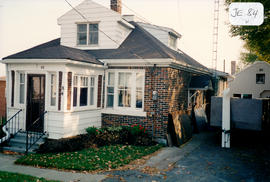- CA BWGPL GJ-HB-2017-04-04-14
- Item
- 1996
Part of George Jackson fonds
The mid-block building located at 71 John St. East was built around 1900 in the Edwardian Classicism style. It was once the home of Sam Stein and his son and daughter. He was the owner of the Toronto Manufacturing Co. (maker of baby carriages and wicker furniture). His business was located on the northwest corner of Dissette St. until around 1929. After its end, the house was rented to a number of O.P.P. officers and their families, including Ivan Spence and Sam Irwin (a talented violin player). It was also the home of Joe Kanyo (a market gardener) and his family at one time. Leonard Saint built a large cement garage at the rear of the house. It had a basement for storing vegetables and a ground-level room for vehicles. The house was eventually sold and redesigned into rental apartments.
The large, 2½-storey house has a rectangular plan with a side hall, an asymmetrical façade and a simple, formal composition. It has a prominent, gable roof. The Classical roof form is expressed as a pediment with extended eaves and mixed with the Queen Anne texture of wood shingles. A raised, entrance portico with a flat roof and balustrade with access from the second- floor portico roof is set on a plain entablature ornamented with a band of dentils and set on double posts on brick piers. The single door is off-centre. There are large window openings with high floor to ceiling heights. Multi-paned, double-hung windows are reminiscent of the Queen Anne style. Ground and second-floor windows are set into segmented, arch openings with brick voussoirs and concrete, lug sills. The third-floor windows have wood entablature and plain, wood trim and sills. Wood frame construction is covered with smooth brick and wood-shingle cladding. There is a parged, stone foundation. The portico steps, foundation and balustrade, and entrance door are not original. According to the 2000 inventory, the house is in good condition. It also notes that the original form and many details are still intact. (1, 2, 3)
George Jackson


